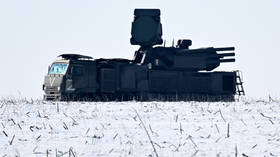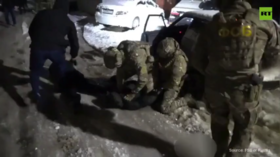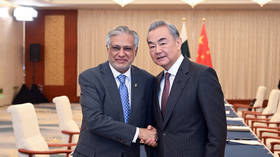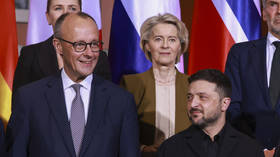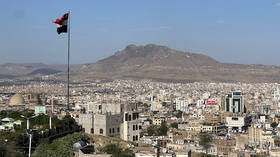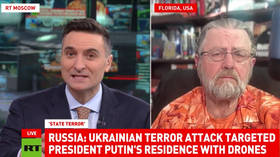Why the Great Famine was not about nationality
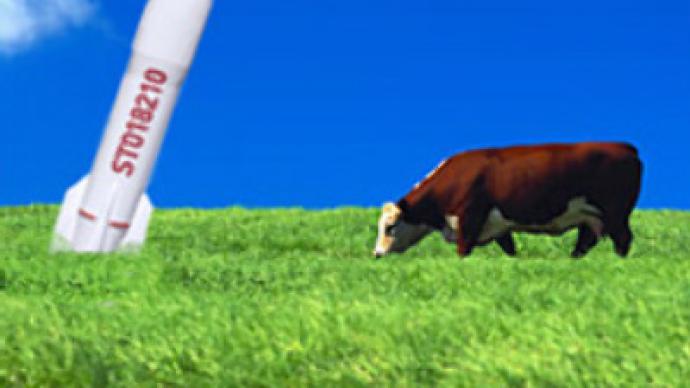
The Great Famine of the 1930s killed millions of people across the USSR. Its origins are still fiercely contested. But according to reports presented at a recent conference in Moscow, its main causes were a failure of ma
The studies were presented at an international scientific conference called Studying The History Of Stalinism: Achievements And Current Problems. The event was held in Moscow in December.
The conference was organised by a range of institutions: Boris Yeltsin’s Foundation, the Commission on Human Rights for the Russian Federation, Russia’s State Archive, the Institute of Scientific Information for the Social Sciences, the Russian Political Encyclopedia publishing house and the International Historical, Educational and Human Rights Charitable Society Memorial. It featured some of the world’s most prominent historians.
Here RT brings you extracts from some of the studies featured at the conference.
Justified move, not justified means
The Great Famine was a direct result of collectivisation, which in turn was the first step towards Stalin’s policy of forced industrialisation.
The Soviet state could only count on its own resources to achieve industrisation, as most of the external world took a cautious if not hostile stance toward the newly-created Socialist state.
And the first problem Stalin encountered on his way to industrialisation was a shortage of food supplies.
“That’s why the idea to control them all appeared in the first place. And to do it Stalin’s government looked to the means of administrative oppression methods of direct violence over peasant population,” Viktor Kondrashin – Doctor of Sciences, head of the department of Fatherland History at Penza State Pedagogical University – said in his study The Famine of 1932-1933 in the USSR.
A body – Committee of Provision – was created specially to consolidate all the food supplies under government control and was headed by Politburo member Valerian Kuybyshev, with soon-to-be-NKVD chief Genrikh Yagoda as his deputy. Back then Yagoda was a prominent OGPU (Joint State Political Directorate – Soviet secret police in 1920s-1930s) member which basically meant that all the grain storages were guarded by the OGPU.
The ultimate goals of Stalin’s policies, according to Kondrashin’s study, were to build plants and to boost agricultural productivity. He naturally didn’t plan the famine. Of course he never really took the interests of the peasantry into serious consideration, but the idea of Stalin having orchestrated the famine is absurd by itself.
“The country was in desperate need of working hands that were to supply the needs of newly constructed plants. Quote from former Prime-Minister Victor Chernomyrdin‘We did our best, you know the rest’ is fully applicable here,” Kondrashin observed.
Following bad counsel
Drastic mistakes were made in planning bread production. The plans were in fact made up out of the blue, based on estimates of the increase of cultivated land.
In this area, as well as later while fighting the famine itself, the disadvantages of Stalin’s bureaucratic system fully presented themselves.
“I have personally studied the so-called ‘issue-related folders’ – a topic-wise sorted collection of key documents that once were the basis of Stalin’s decisions – in the President’s archive and the first and most important idea that I got from them was that Stalin very much relied on his self-styled group of ‘experts’: the Peoples’ Commissariat of farming, the Committee of Provision, Peoples’ Commissariat of Supplies,” Kondrashin claims.
“When he has a report of inadequate planning or of a famine from certain sources he immediately turned to his ‘experts’: Chernov, Mikoyan, Kaganovich, Yakovlev, who in turn gave him their ideas – how big the emergency is, should the grain be sent, how much of it should be sent etc. Based on these, Stalin makes his decision”.
“What is really interesting is that after a careful study of the folders for 1930-1932, I haven’t found a single issue on which Stalin’s final decision didn’t go in line with his ‘expert’s’ view,” he added.
The so-called ‘experts’ were hardly capable of giving qualified counsel on agriculture.
Mikhail Chernov’s only education was attained at the physics and mathematics faculty of Moscow University, from which he never graduated. He also had no experience in agriculture in 1930 when he headed the Soyuzkhleb (National Bread Union).
A Tbilisi Theological Seminary graduate, Anastas Mikoyan had no connection with agriculture and throughout the years showed himself capable only of making speeches and importing ideas from the West.
In a state ruled by the working class, Lazar Kaganovich’s counsel was probably especially valued, but it turned out to be as useful as that of an uneducated ex-shoe factory worker, which he was.
Former Petrograd polytechnic institute student (again, not a graduate), Yakov Epstein-Yakovlev, had a revolutionary-military background, but somehow – probably due to coming from an agriculturally significant region in Belarus – was appointed the Commissar of farming.
Local authorities: ambitious planning, concealing failures
Recently declassified documents reveal more failings of management. Kondrashin points out that too great a role was given to local authorities in implementing complicated instructions given from Moscow.
The example of Ukraine is a vivid one, with Moscow getting contradictory reports from their network of sources and from Stanislav Kosior – General Secretary of the Communist Party of the Ukrainian Republic.
Civil War hero and military leader, Semyon Budyonny, was particularly infuriated by this. During a visit to Ukraine in 1932, he called for Kosior to be shot for organising the famine by nominating unrealistic plans of bread production.
Stalin sent his own emissaries to Ukraine, who confirmed the reports of famine. Only then did Kosior acknowledge the scale of the emergency, which he had earlier played down.
Still, there were no real differences between Moscow’s policies concerning peasants in different areas. Strict control over both the goods and the peasants, who had no right to move beyond their regions, was implemented in most of the agriculturally significant areas: Ukraine, Povolzhye (Volga river basin), Northern Caucasus and Kazakhstan.
According to renowned British historian Dr. Robert Conquest, the main blow from the famine was taken by the Volga Germans – ethnic Germans, whose ancestors were invited by Catherine the Great to settle along the Volga River.
Tragedy in the Povolzhye region
Another agricultural heartland that suffered dreadfully during the Soviet famine was Povolzhye.
Historically it had been a geopolitical divider between Central and Eastern parts of Russia (note that until the 18th century it was also a natural border between Europe and Asia).
Despite having a diverse population and a wide range of languages, including Slavic, Finno-Ugric and Turkic, Povolzhye’s remained a multicultural region with a high level of integration among its inhabitants.
But this multiculturalism remained local. The Volga River itself was a natural barrier but also a means of communication. Principles of tolerance evolved in the region over centuries, creating friendly economic relations.
By the 1920s, local ethnic republics were being created erratically: while Tatar, Chuvash, and Mari were established quickly, Mordovian statehood appeared only in 1928 and wasn’t in fact built on ethnic principles initially.
These unevenly created states were a factor for local agricultural policies, as Valerii Yurchenkov – Doctor of history and director of the Scientific Research Institute for the Humanities attached to the government of the Mordovian Republic – insisted, while presenting his study on Stalinist Agrarian Policy in the Volga National Republics.
“As most of the Soviet laws in these regions were applied according to local traditions. Russophobic tendencies that started to gain momentum in the Povolzhye region in the late 1920s and continued till mid 1930s were another factor. So too was the grossly underdeveloped industry and the domination of non-lucrative farming,” Yurchenkov said.
“It has to be said that neither the land nor other resources were distributed equally to representatives of different nationalities in the Povolzhye region, who started to fall behind in terms of social development,” he added.
Leaders like Ibrahimov in Tatarstan, Vasilyev in Mordovia strived to achieve actual independence using the agricultural advantages of the region. The Kremlin attempted to consider all of this during collectivization. That is why Mordovia planned to end it in spring 1931, while Chuvash and Mari regions had an extra year.
However, in practice, local elites tried to boost the pace of collectivization, with oppressive methods typical of the Soviet regime.
This helped the Republic of Volga Germans – the first to report the completion of collectivisation as early as the end of 1930. But it also caused widespread peasant protests, which rendered the general attitude towards the Soviet agricultural policies as strictly negative.
Short- and long-term effects
So even though Moscow’s agricultural policies were harsh, local elites did little to improve the situation by taking ambitious obligations to distinguish themselves, and then trying hard to conceal failure.
Meanwhile, the crops were diminishing. A letter from a member of the Council of Labour and Defence to the Committee of Provision chair states that by the start of 1933 the Soviet Union had only had 7.2 billion kilograms of grain in reserve, while by the start of 1931 – they exceeded 16.4 billion kilograms.
Stalin's government was able to change the attitude only in the mid 1930s by giving substantial concessions to the peasantry. By then key agricultural areas had already suffered the biggest of the short-term effects of the Soviet agricultural policies – the Great Famine, which had of course political, socio-economical and climatic causes. But that the main ones were political is undisputable.
The long-term effects of the Soviet agricultural policies of the 1920s-1930s were no less remarkable. They entirely changed the structure of the peasantry. Its traditional system was brought down and never revived, but this is overshadowed by the fact that between 7 and 8 million people died in the famine.
Reluctant Ukrainians
“We have all the proofs to state that the economic specialization of each particular region affected the casualties, which were directly proportional to the amount of grain and bread produced there,” Kondrashin said, insisting on a regional rather than an ethnic basis for the famine.
He also noted that the Great Famine issue is highly politicized today, stressing that despite a contrary belief Russia isn’t trying to play down the tragedy of Soviet peasants.
According to Kondrashin, numerous books have been published in recent years, outlining the concept of the tragedy in terms of a peasant state.
An exhibition of newly declassified documents from the President’s and the FSB archives as well as the Russian State Archive of Socio-Political History was held in Moscow not long ago.
A massive historical work is being done now under Federal Archive Agency supervision to create a massive collection of documents relating to the Famine in the USSR between 1929 and 1934. The talk is now of declassifying documents regarding the grain reserves and its export in the years of the famine.
“Historians from Kazakhstan, Belarus, Kyrgyzstan participate in this project, while historians from Ukraine flatly refuse, though we have offered them the opportunity to present any documents they find as appropriate evidence of famine and/or genocide,” Kondrashin said. “I’d like to call them once again to help us in creating this monument to Soviet peasantry – a class that was the backbone of this country for centuries.”
Ruben Zarbabyan, RT


